Finance for Business: Analysis of Abilene Oil and Gas Limited (ABL)
VerifiedAdded on 2020/09/08
|14
|2954
|77
Report
AI Summary
This report provides a detailed financial analysis of Abilene Oil and Gas Limited (ABL). It begins with a brief overview of the company and its objectives, followed by an examination of its ownership and governance structure, including the identification of major shareholders and internal stakeholders. The report then delves into the analysis of key financial ratios, including market capitalization, enterprise value, and debt levels. A significant portion of the report focuses on the analysis of ABL's share price performance, comparing its movements against the All Ordinaries index over a two-year period and assessing the impact of market news on share prices. The report further calculates the beta for ABL, determines the required rate of return using the Capital Asset Pricing Model (CAPM), and evaluates the company's investment strategy. Additionally, it computes the Weighted Average Cost of Capital (WACC) and analyzes the company's debt ratio and dividend policy. The report concludes with recommendations for the company's financial strategy, providing a comprehensive assessment of ABL's financial health and performance.

Finance For Business
Paraphrase This Document
Need a fresh take? Get an instant paraphrase of this document with our AI Paraphraser
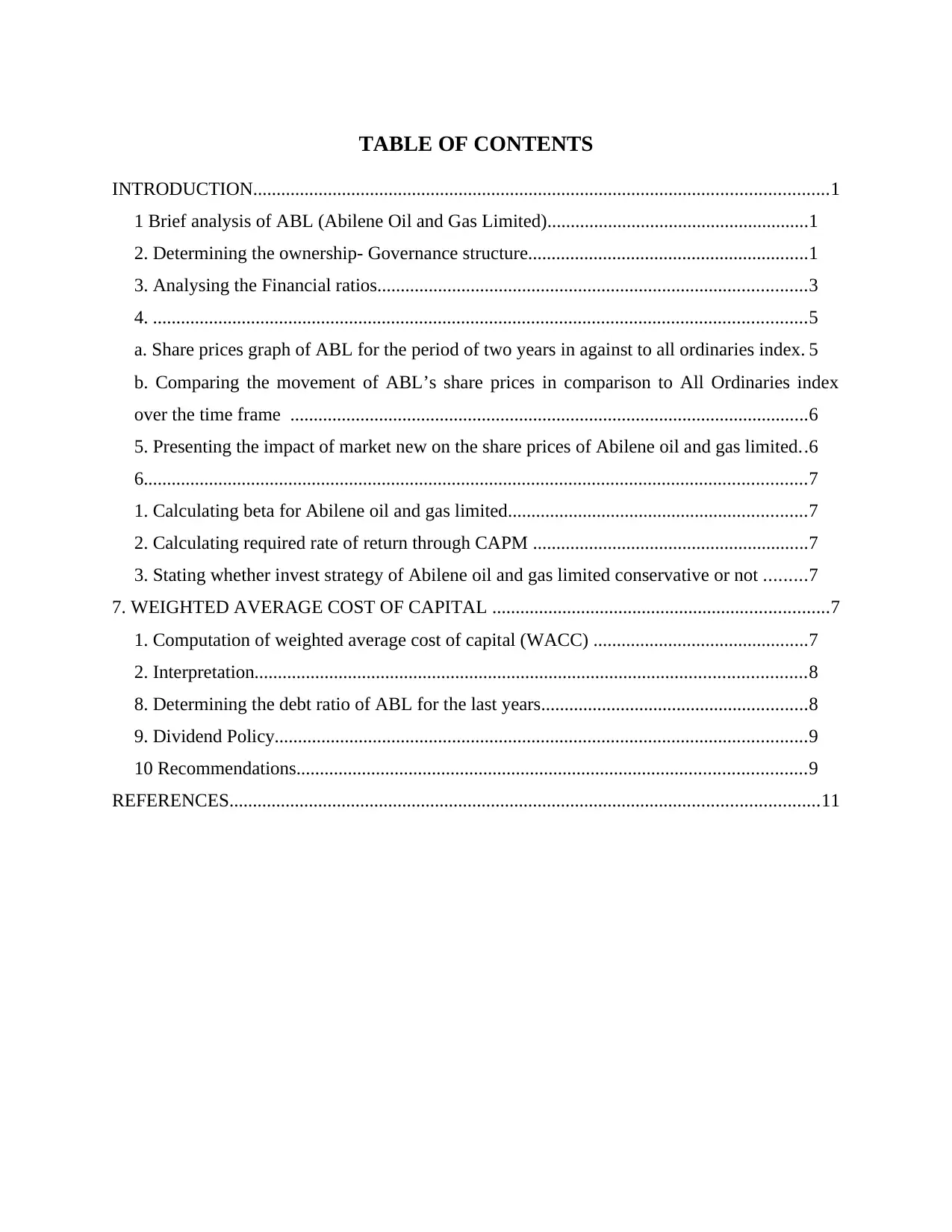
TABLE OF CONTENTS
INTRODUCTION...........................................................................................................................1
1 Brief analysis of ABL (Abilene Oil and Gas Limited)........................................................1
2. Determining the ownership- Governance structure............................................................1
3. Analysing the Financial ratios............................................................................................3
4. ............................................................................................................................................5
a. Share prices graph of ABL for the period of two years in against to all ordinaries index. 5
b. Comparing the movement of ABL’s share prices in comparison to All Ordinaries index
over the time frame ...............................................................................................................6
5. Presenting the impact of market new on the share prices of Abilene oil and gas limited..6
6..............................................................................................................................................7
1. Calculating beta for Abilene oil and gas limited................................................................7
2. Calculating required rate of return through CAPM ...........................................................7
3. Stating whether invest strategy of Abilene oil and gas limited conservative or not .........7
7. WEIGHTED AVERAGE COST OF CAPITAL ........................................................................7
1. Computation of weighted average cost of capital (WACC) ..............................................7
2. Interpretation......................................................................................................................8
8. Determining the debt ratio of ABL for the last years.........................................................8
9. Dividend Policy..................................................................................................................9
10 Recommendations.............................................................................................................9
REFERENCES..............................................................................................................................11
INTRODUCTION...........................................................................................................................1
1 Brief analysis of ABL (Abilene Oil and Gas Limited)........................................................1
2. Determining the ownership- Governance structure............................................................1
3. Analysing the Financial ratios............................................................................................3
4. ............................................................................................................................................5
a. Share prices graph of ABL for the period of two years in against to all ordinaries index. 5
b. Comparing the movement of ABL’s share prices in comparison to All Ordinaries index
over the time frame ...............................................................................................................6
5. Presenting the impact of market new on the share prices of Abilene oil and gas limited..6
6..............................................................................................................................................7
1. Calculating beta for Abilene oil and gas limited................................................................7
2. Calculating required rate of return through CAPM ...........................................................7
3. Stating whether invest strategy of Abilene oil and gas limited conservative or not .........7
7. WEIGHTED AVERAGE COST OF CAPITAL ........................................................................7
1. Computation of weighted average cost of capital (WACC) ..............................................7
2. Interpretation......................................................................................................................8
8. Determining the debt ratio of ABL for the last years.........................................................8
9. Dividend Policy..................................................................................................................9
10 Recommendations.............................................................................................................9
REFERENCES..............................................................................................................................11
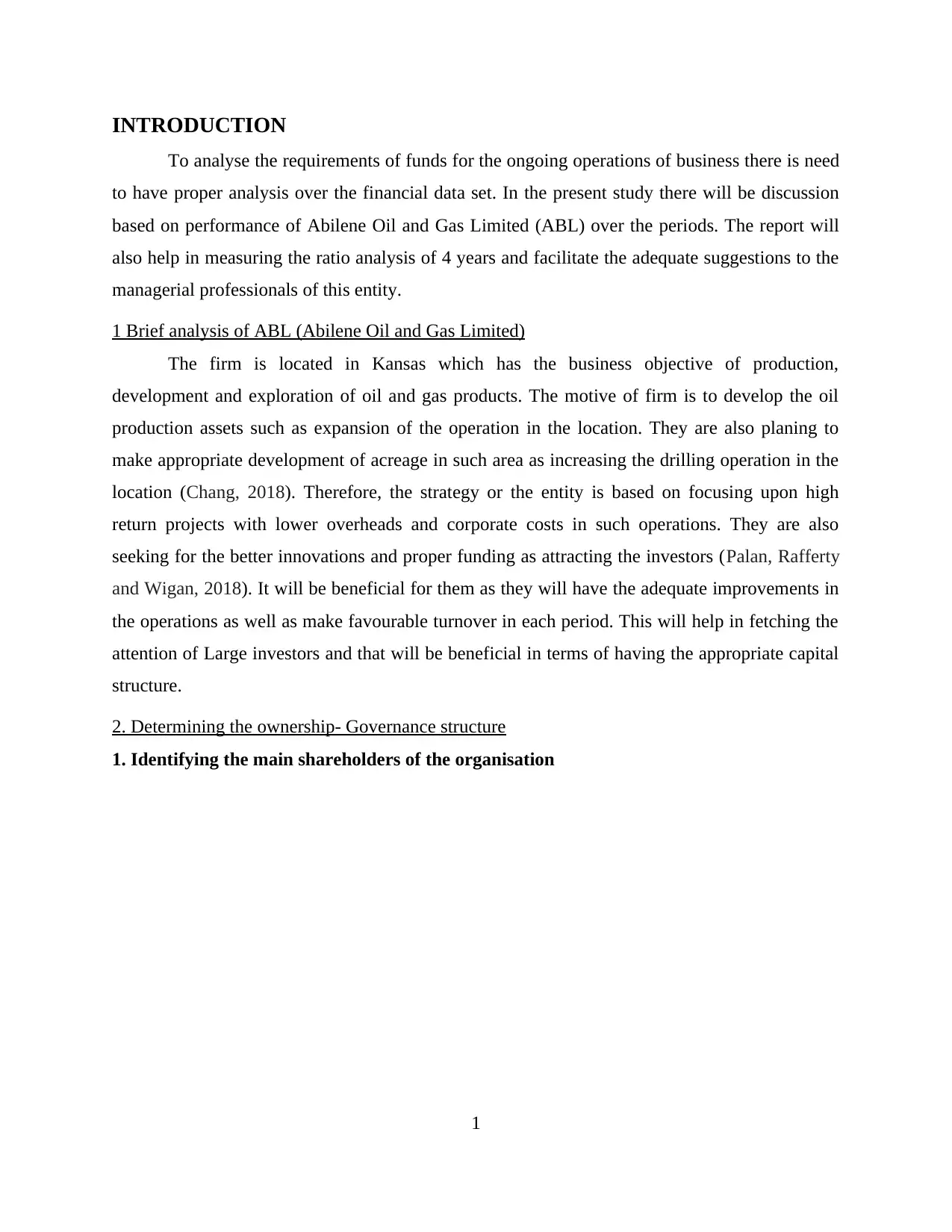
INTRODUCTION
To analyse the requirements of funds for the ongoing operations of business there is need
to have proper analysis over the financial data set. In the present study there will be discussion
based on performance of Abilene Oil and Gas Limited (ABL) over the periods. The report will
also help in measuring the ratio analysis of 4 years and facilitate the adequate suggestions to the
managerial professionals of this entity.
1 Brief analysis of ABL (Abilene Oil and Gas Limited)
The firm is located in Kansas which has the business objective of production,
development and exploration of oil and gas products. The motive of firm is to develop the oil
production assets such as expansion of the operation in the location. They are also planing to
make appropriate development of acreage in such area as increasing the drilling operation in the
location (Chang, 2018). Therefore, the strategy or the entity is based on focusing upon high
return projects with lower overheads and corporate costs in such operations. They are also
seeking for the better innovations and proper funding as attracting the investors (Palan, Rafferty
and Wigan, 2018). It will be beneficial for them as they will have the adequate improvements in
the operations as well as make favourable turnover in each period. This will help in fetching the
attention of Large investors and that will be beneficial in terms of having the appropriate capital
structure.
2. Determining the ownership- Governance structure
1. Identifying the main shareholders of the organisation
1
To analyse the requirements of funds for the ongoing operations of business there is need
to have proper analysis over the financial data set. In the present study there will be discussion
based on performance of Abilene Oil and Gas Limited (ABL) over the periods. The report will
also help in measuring the ratio analysis of 4 years and facilitate the adequate suggestions to the
managerial professionals of this entity.
1 Brief analysis of ABL (Abilene Oil and Gas Limited)
The firm is located in Kansas which has the business objective of production,
development and exploration of oil and gas products. The motive of firm is to develop the oil
production assets such as expansion of the operation in the location. They are also planing to
make appropriate development of acreage in such area as increasing the drilling operation in the
location (Chang, 2018). Therefore, the strategy or the entity is based on focusing upon high
return projects with lower overheads and corporate costs in such operations. They are also
seeking for the better innovations and proper funding as attracting the investors (Palan, Rafferty
and Wigan, 2018). It will be beneficial for them as they will have the adequate improvements in
the operations as well as make favourable turnover in each period. This will help in fetching the
attention of Large investors and that will be beneficial in terms of having the appropriate capital
structure.
2. Determining the ownership- Governance structure
1. Identifying the main shareholders of the organisation
1
⊘ This is a preview!⊘
Do you want full access?
Subscribe today to unlock all pages.

Trusted by 1+ million students worldwide

More than 20% of equity holdings of ABL:
In accordance with the shareholders of ABL there are maximum stakeholders are holding
the shares which are more than 20% as reflect in the above diagram. However, they are holding
49% of equity of ABL as per the current disclosure of the organisation for the period 2017.
More than 5% of the shareholdings:
In context with the above listed diagram it can be said that only one equity holder is
holding the share which is below than 20% such as 14.7% while in general all the shareholders
are holding more than 5% of the total equity.
2. Identifying the main internal stakeholders of the company
Audit Committee
Paul Salter Non- Executive Chairman
Craig Mathieson B. Bus Non- Executive Director
Mordechai Benedikt Non- Executive Director
Key Executives Melanie Jay Leydin
B. Bus, CA
Company Secretary
2
In accordance with the shareholders of ABL there are maximum stakeholders are holding
the shares which are more than 20% as reflect in the above diagram. However, they are holding
49% of equity of ABL as per the current disclosure of the organisation for the period 2017.
More than 5% of the shareholdings:
In context with the above listed diagram it can be said that only one equity holder is
holding the share which is below than 20% such as 14.7% while in general all the shareholders
are holding more than 5% of the total equity.
2. Identifying the main internal stakeholders of the company
Audit Committee
Paul Salter Non- Executive Chairman
Craig Mathieson B. Bus Non- Executive Director
Mordechai Benedikt Non- Executive Director
Key Executives Melanie Jay Leydin
B. Bus, CA
Company Secretary
2
Paraphrase This Document
Need a fresh take? Get an instant paraphrase of this document with our AI Paraphraser
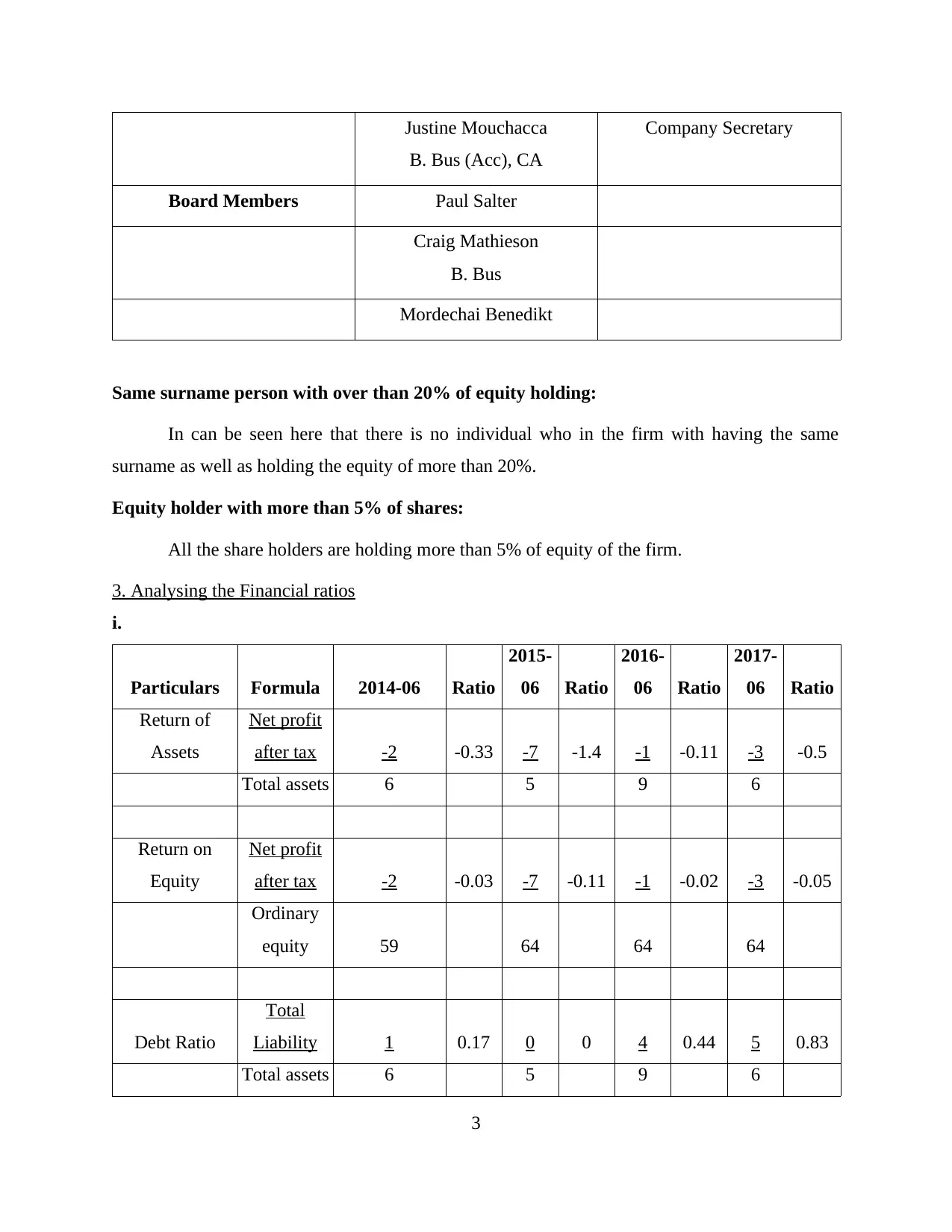
Justine Mouchacca
B. Bus (Acc), CA
Company Secretary
Board Members Paul Salter
Craig Mathieson
B. Bus
Mordechai Benedikt
Same surname person with over than 20% of equity holding:
In can be seen here that there is no individual who in the firm with having the same
surname as well as holding the equity of more than 20%.
Equity holder with more than 5% of shares:
All the share holders are holding more than 5% of equity of the firm.
3. Analysing the Financial ratios
i.
Particulars Formula 2014-06 Ratio
2015-
06 Ratio
2016-
06 Ratio
2017-
06 Ratio
Return of
Assets
Net profit
after tax -2 -0.33 -7 -1.4 -1 -0.11 -3 -0.5
Total assets 6 5 9 6
Return on
Equity
Net profit
after tax -2 -0.03 -7 -0.11 -1 -0.02 -3 -0.05
Ordinary
equity 59 64 64 64
Debt Ratio
Total
Liability 1 0.17 0 0 4 0.44 5 0.83
Total assets 6 5 9 6
3
B. Bus (Acc), CA
Company Secretary
Board Members Paul Salter
Craig Mathieson
B. Bus
Mordechai Benedikt
Same surname person with over than 20% of equity holding:
In can be seen here that there is no individual who in the firm with having the same
surname as well as holding the equity of more than 20%.
Equity holder with more than 5% of shares:
All the share holders are holding more than 5% of equity of the firm.
3. Analysing the Financial ratios
i.
Particulars Formula 2014-06 Ratio
2015-
06 Ratio
2016-
06 Ratio
2017-
06 Ratio
Return of
Assets
Net profit
after tax -2 -0.33 -7 -1.4 -1 -0.11 -3 -0.5
Total assets 6 5 9 6
Return on
Equity
Net profit
after tax -2 -0.03 -7 -0.11 -1 -0.02 -3 -0.05
Ordinary
equity 59 64 64 64
Debt Ratio
Total
Liability 1 0.17 0 0 4 0.44 5 0.83
Total assets 6 5 9 6
3
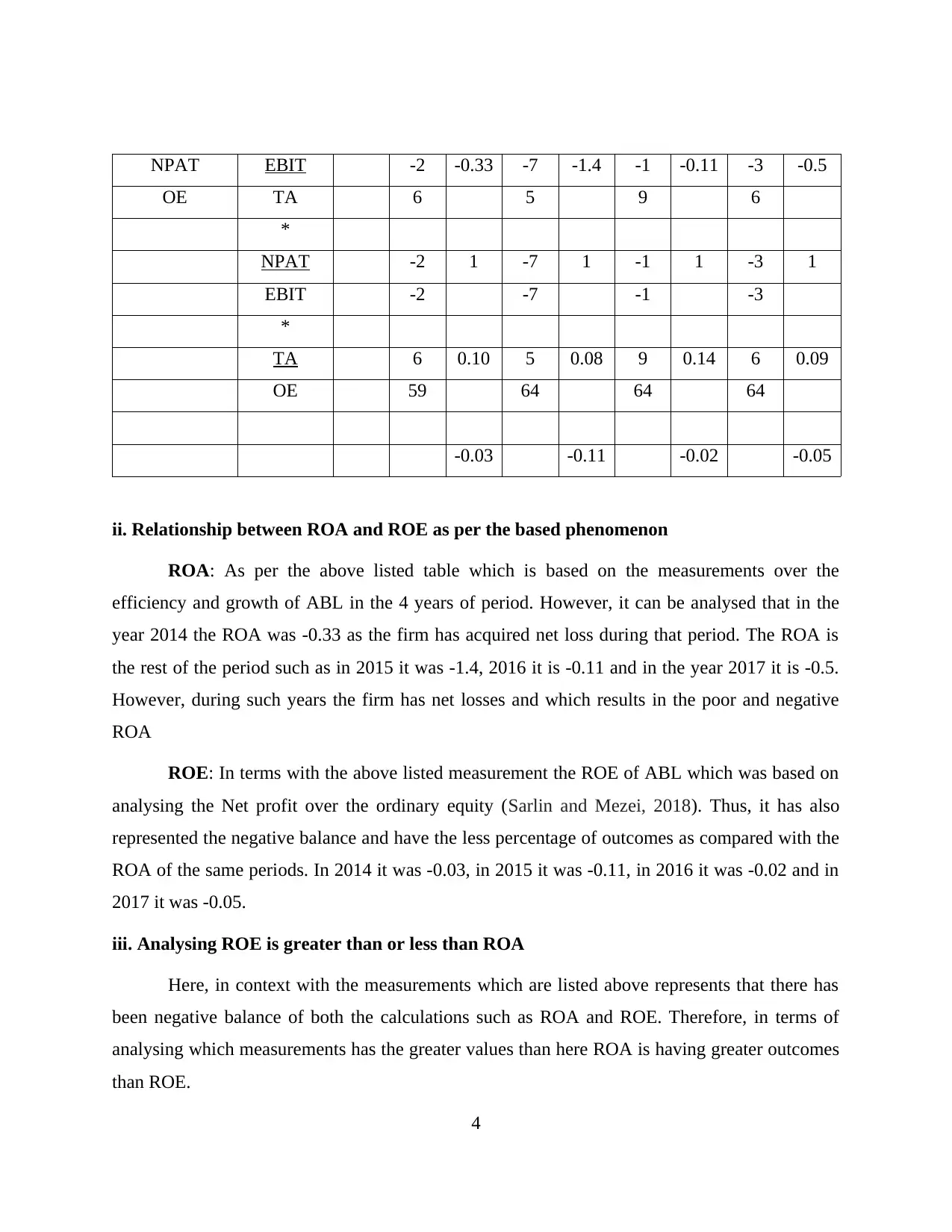
NPAT EBIT -2 -0.33 -7 -1.4 -1 -0.11 -3 -0.5
OE TA 6 5 9 6
*
NPAT -2 1 -7 1 -1 1 -3 1
EBIT -2 -7 -1 -3
*
TA 6 0.10 5 0.08 9 0.14 6 0.09
OE 59 64 64 64
-0.03 -0.11 -0.02 -0.05
ii. Relationship between ROA and ROE as per the based phenomenon
ROA: As per the above listed table which is based on the measurements over the
efficiency and growth of ABL in the 4 years of period. However, it can be analysed that in the
year 2014 the ROA was -0.33 as the firm has acquired net loss during that period. The ROA is
the rest of the period such as in 2015 it was -1.4, 2016 it is -0.11 and in the year 2017 it is -0.5.
However, during such years the firm has net losses and which results in the poor and negative
ROA
ROE: In terms with the above listed measurement the ROE of ABL which was based on
analysing the Net profit over the ordinary equity (Sarlin and Mezei, 2018). Thus, it has also
represented the negative balance and have the less percentage of outcomes as compared with the
ROA of the same periods. In 2014 it was -0.03, in 2015 it was -0.11, in 2016 it was -0.02 and in
2017 it was -0.05.
iii. Analysing ROE is greater than or less than ROA
Here, in context with the measurements which are listed above represents that there has
been negative balance of both the calculations such as ROA and ROE. Therefore, in terms of
analysing which measurements has the greater values than here ROA is having greater outcomes
than ROE.
4
OE TA 6 5 9 6
*
NPAT -2 1 -7 1 -1 1 -3 1
EBIT -2 -7 -1 -3
*
TA 6 0.10 5 0.08 9 0.14 6 0.09
OE 59 64 64 64
-0.03 -0.11 -0.02 -0.05
ii. Relationship between ROA and ROE as per the based phenomenon
ROA: As per the above listed table which is based on the measurements over the
efficiency and growth of ABL in the 4 years of period. However, it can be analysed that in the
year 2014 the ROA was -0.33 as the firm has acquired net loss during that period. The ROA is
the rest of the period such as in 2015 it was -1.4, 2016 it is -0.11 and in the year 2017 it is -0.5.
However, during such years the firm has net losses and which results in the poor and negative
ROA
ROE: In terms with the above listed measurement the ROE of ABL which was based on
analysing the Net profit over the ordinary equity (Sarlin and Mezei, 2018). Thus, it has also
represented the negative balance and have the less percentage of outcomes as compared with the
ROA of the same periods. In 2014 it was -0.03, in 2015 it was -0.11, in 2016 it was -0.02 and in
2017 it was -0.05.
iii. Analysing ROE is greater than or less than ROA
Here, in context with the measurements which are listed above represents that there has
been negative balance of both the calculations such as ROA and ROE. Therefore, in terms of
analysing which measurements has the greater values than here ROA is having greater outcomes
than ROE.
4
⊘ This is a preview!⊘
Do you want full access?
Subscribe today to unlock all pages.

Trusted by 1+ million students worldwide
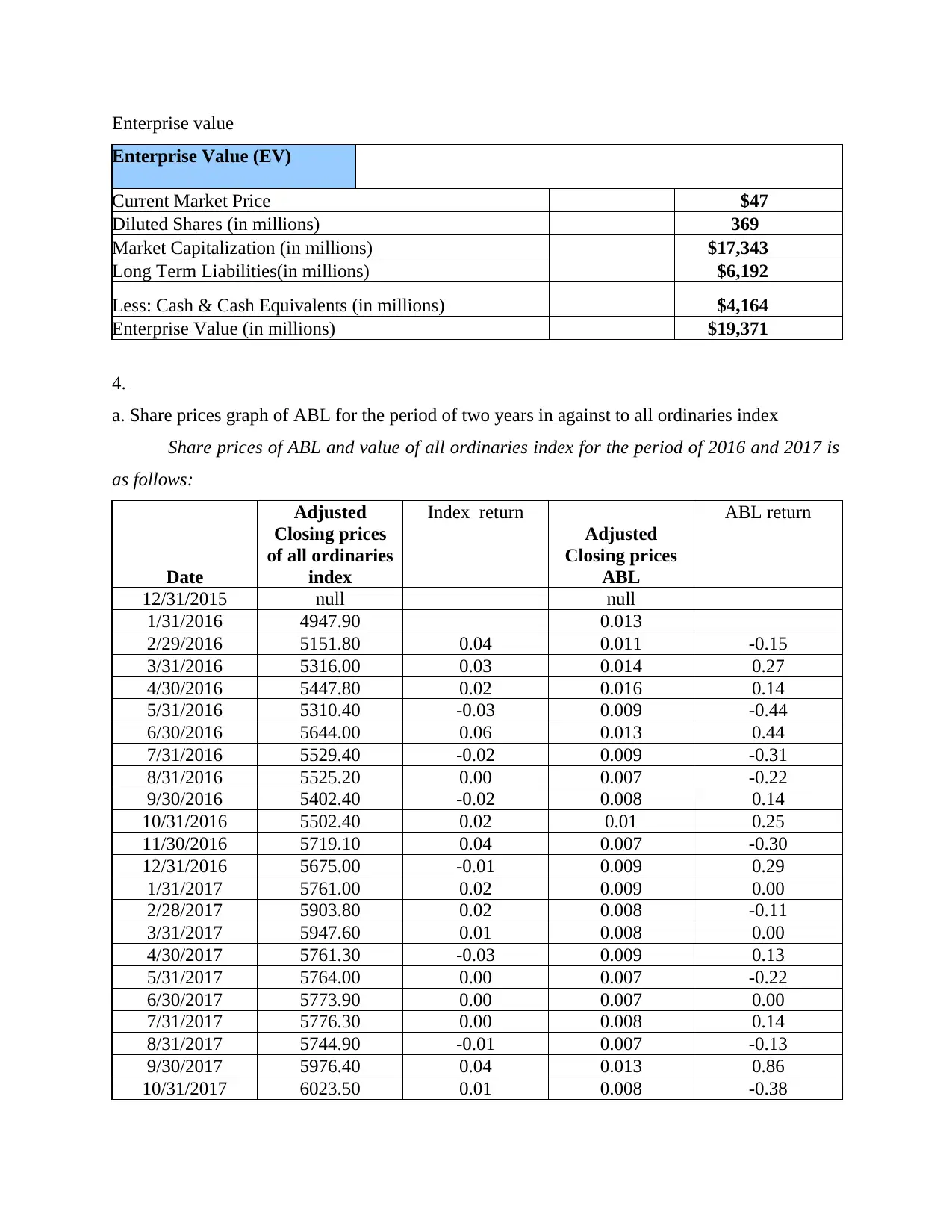
Enterprise value
Enterprise Value (EV)
Current Market Price $47
Diluted Shares (in millions) 369
Market Capitalization (in millions) $17,343
Long Term Liabilities(in millions) $6,192
Less: Cash & Cash Equivalents (in millions) $4,164
Enterprise Value (in millions) $19,371
4.
a. Share prices graph of ABL for the period of two years in against to all ordinaries index
Share prices of ABL and value of all ordinaries index for the period of 2016 and 2017 is
as follows:
Date
Adjusted
Closing prices
of all ordinaries
index
Index return
Adjusted
Closing prices
ABL
ABL return
12/31/2015 null null
1/31/2016 4947.90 0.013
2/29/2016 5151.80 0.04 0.011 -0.15
3/31/2016 5316.00 0.03 0.014 0.27
4/30/2016 5447.80 0.02 0.016 0.14
5/31/2016 5310.40 -0.03 0.009 -0.44
6/30/2016 5644.00 0.06 0.013 0.44
7/31/2016 5529.40 -0.02 0.009 -0.31
8/31/2016 5525.20 0.00 0.007 -0.22
9/30/2016 5402.40 -0.02 0.008 0.14
10/31/2016 5502.40 0.02 0.01 0.25
11/30/2016 5719.10 0.04 0.007 -0.30
12/31/2016 5675.00 -0.01 0.009 0.29
1/31/2017 5761.00 0.02 0.009 0.00
2/28/2017 5903.80 0.02 0.008 -0.11
3/31/2017 5947.60 0.01 0.008 0.00
4/30/2017 5761.30 -0.03 0.009 0.13
5/31/2017 5764.00 0.00 0.007 -0.22
6/30/2017 5773.90 0.00 0.007 0.00
7/31/2017 5776.30 0.00 0.008 0.14
8/31/2017 5744.90 -0.01 0.007 -0.13
9/30/2017 5976.40 0.04 0.013 0.86
10/31/2017 6023.50 0.01 0.008 -0.38
Enterprise Value (EV)
Current Market Price $47
Diluted Shares (in millions) 369
Market Capitalization (in millions) $17,343
Long Term Liabilities(in millions) $6,192
Less: Cash & Cash Equivalents (in millions) $4,164
Enterprise Value (in millions) $19,371
4.
a. Share prices graph of ABL for the period of two years in against to all ordinaries index
Share prices of ABL and value of all ordinaries index for the period of 2016 and 2017 is
as follows:
Date
Adjusted
Closing prices
of all ordinaries
index
Index return
Adjusted
Closing prices
ABL
ABL return
12/31/2015 null null
1/31/2016 4947.90 0.013
2/29/2016 5151.80 0.04 0.011 -0.15
3/31/2016 5316.00 0.03 0.014 0.27
4/30/2016 5447.80 0.02 0.016 0.14
5/31/2016 5310.40 -0.03 0.009 -0.44
6/30/2016 5644.00 0.06 0.013 0.44
7/31/2016 5529.40 -0.02 0.009 -0.31
8/31/2016 5525.20 0.00 0.007 -0.22
9/30/2016 5402.40 -0.02 0.008 0.14
10/31/2016 5502.40 0.02 0.01 0.25
11/30/2016 5719.10 0.04 0.007 -0.30
12/31/2016 5675.00 -0.01 0.009 0.29
1/31/2017 5761.00 0.02 0.009 0.00
2/28/2017 5903.80 0.02 0.008 -0.11
3/31/2017 5947.60 0.01 0.008 0.00
4/30/2017 5761.30 -0.03 0.009 0.13
5/31/2017 5764.00 0.00 0.007 -0.22
6/30/2017 5773.90 0.00 0.007 0.00
7/31/2017 5776.30 0.00 0.008 0.14
8/31/2017 5744.90 -0.01 0.007 -0.13
9/30/2017 5976.40 0.04 0.013 0.86
10/31/2017 6023.50 0.01 0.008 -0.38
Paraphrase This Document
Need a fresh take? Get an instant paraphrase of this document with our AI Paraphraser
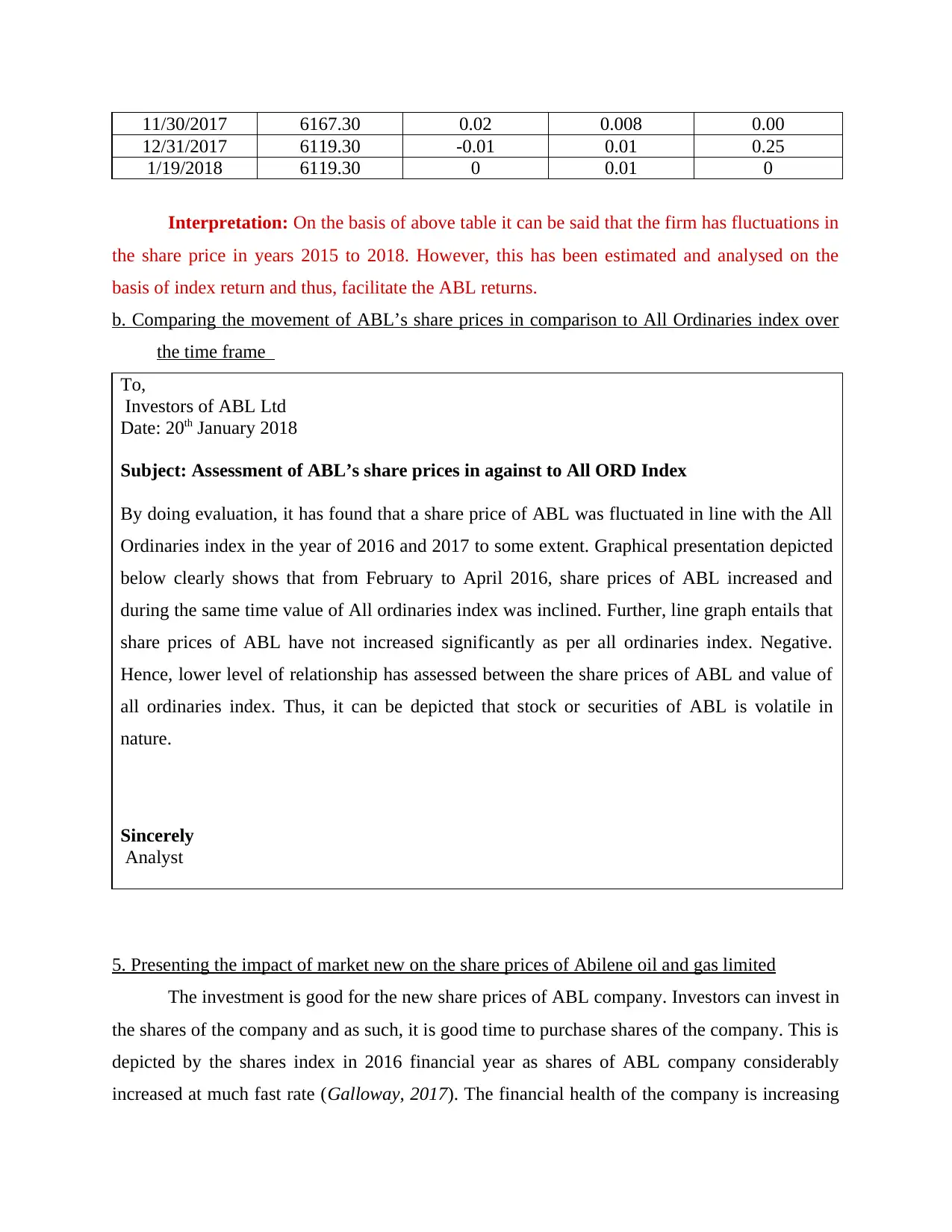
11/30/2017 6167.30 0.02 0.008 0.00
12/31/2017 6119.30 -0.01 0.01 0.25
1/19/2018 6119.30 0 0.01 0
Interpretation: On the basis of above table it can be said that the firm has fluctuations in
the share price in years 2015 to 2018. However, this has been estimated and analysed on the
basis of index return and thus, facilitate the ABL returns.
b. Comparing the movement of ABL’s share prices in comparison to All Ordinaries index over
the time frame
To,
Investors of ABL Ltd
Date: 20th January 2018
Subject: Assessment of ABL’s share prices in against to All ORD Index
By doing evaluation, it has found that a share price of ABL was fluctuated in line with the All
Ordinaries index in the year of 2016 and 2017 to some extent. Graphical presentation depicted
below clearly shows that from February to April 2016, share prices of ABL increased and
during the same time value of All ordinaries index was inclined. Further, line graph entails that
share prices of ABL have not increased significantly as per all ordinaries index. Negative.
Hence, lower level of relationship has assessed between the share prices of ABL and value of
all ordinaries index. Thus, it can be depicted that stock or securities of ABL is volatile in
nature.
Sincerely
Analyst
5. Presenting the impact of market new on the share prices of Abilene oil and gas limited
The investment is good for the new share prices of ABL company. Investors can invest in
the shares of the company and as such, it is good time to purchase shares of the company. This is
depicted by the shares index in 2016 financial year as shares of ABL company considerably
increased at much fast rate (Galloway, 2017). The financial health of the company is increasing
12/31/2017 6119.30 -0.01 0.01 0.25
1/19/2018 6119.30 0 0.01 0
Interpretation: On the basis of above table it can be said that the firm has fluctuations in
the share price in years 2015 to 2018. However, this has been estimated and analysed on the
basis of index return and thus, facilitate the ABL returns.
b. Comparing the movement of ABL’s share prices in comparison to All Ordinaries index over
the time frame
To,
Investors of ABL Ltd
Date: 20th January 2018
Subject: Assessment of ABL’s share prices in against to All ORD Index
By doing evaluation, it has found that a share price of ABL was fluctuated in line with the All
Ordinaries index in the year of 2016 and 2017 to some extent. Graphical presentation depicted
below clearly shows that from February to April 2016, share prices of ABL increased and
during the same time value of All ordinaries index was inclined. Further, line graph entails that
share prices of ABL have not increased significantly as per all ordinaries index. Negative.
Hence, lower level of relationship has assessed between the share prices of ABL and value of
all ordinaries index. Thus, it can be depicted that stock or securities of ABL is volatile in
nature.
Sincerely
Analyst
5. Presenting the impact of market new on the share prices of Abilene oil and gas limited
The investment is good for the new share prices of ABL company. Investors can invest in
the shares of the company and as such, it is good time to purchase shares of the company. This is
depicted by the shares index in 2016 financial year as shares of ABL company considerably
increased at much fast rate (Galloway, 2017). The financial health of the company is increasing
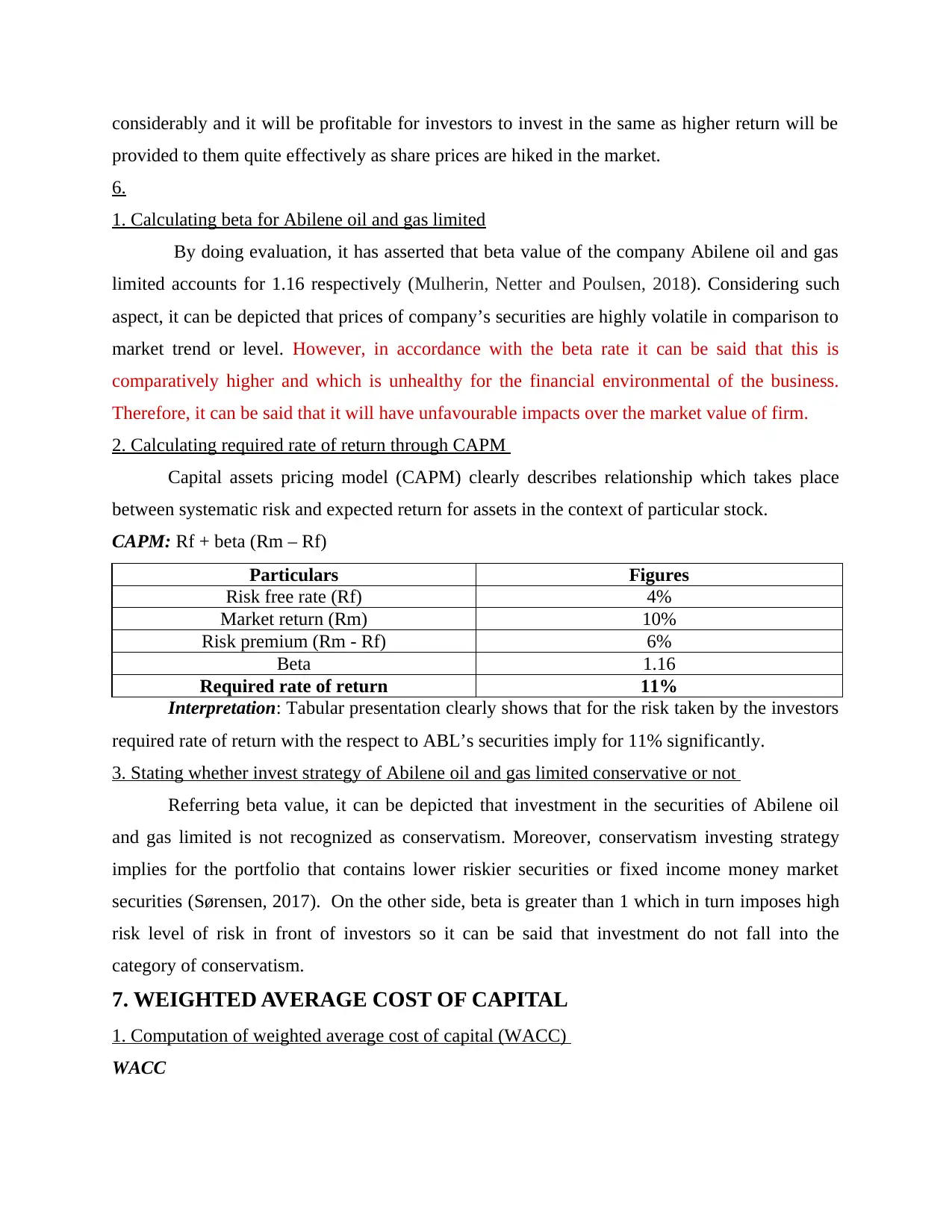
considerably and it will be profitable for investors to invest in the same as higher return will be
provided to them quite effectively as share prices are hiked in the market.
6.
1. Calculating beta for Abilene oil and gas limited
By doing evaluation, it has asserted that beta value of the company Abilene oil and gas
limited accounts for 1.16 respectively (Mulherin, Netter and Poulsen, 2018). Considering such
aspect, it can be depicted that prices of company’s securities are highly volatile in comparison to
market trend or level. However, in accordance with the beta rate it can be said that this is
comparatively higher and which is unhealthy for the financial environmental of the business.
Therefore, it can be said that it will have unfavourable impacts over the market value of firm.
2. Calculating required rate of return through CAPM
Capital assets pricing model (CAPM) clearly describes relationship which takes place
between systematic risk and expected return for assets in the context of particular stock.
CAPM: Rf + beta (Rm – Rf)
Particulars Figures
Risk free rate (Rf) 4%
Market return (Rm) 10%
Risk premium (Rm - Rf) 6%
Beta 1.16
Required rate of return 11%
Interpretation: Tabular presentation clearly shows that for the risk taken by the investors
required rate of return with the respect to ABL’s securities imply for 11% significantly.
3. Stating whether invest strategy of Abilene oil and gas limited conservative or not
Referring beta value, it can be depicted that investment in the securities of Abilene oil
and gas limited is not recognized as conservatism. Moreover, conservatism investing strategy
implies for the portfolio that contains lower riskier securities or fixed income money market
securities (Sørensen, 2017). On the other side, beta is greater than 1 which in turn imposes high
risk level of risk in front of investors so it can be said that investment do not fall into the
category of conservatism.
7. WEIGHTED AVERAGE COST OF CAPITAL
1. Computation of weighted average cost of capital (WACC)
WACC
provided to them quite effectively as share prices are hiked in the market.
6.
1. Calculating beta for Abilene oil and gas limited
By doing evaluation, it has asserted that beta value of the company Abilene oil and gas
limited accounts for 1.16 respectively (Mulherin, Netter and Poulsen, 2018). Considering such
aspect, it can be depicted that prices of company’s securities are highly volatile in comparison to
market trend or level. However, in accordance with the beta rate it can be said that this is
comparatively higher and which is unhealthy for the financial environmental of the business.
Therefore, it can be said that it will have unfavourable impacts over the market value of firm.
2. Calculating required rate of return through CAPM
Capital assets pricing model (CAPM) clearly describes relationship which takes place
between systematic risk and expected return for assets in the context of particular stock.
CAPM: Rf + beta (Rm – Rf)
Particulars Figures
Risk free rate (Rf) 4%
Market return (Rm) 10%
Risk premium (Rm - Rf) 6%
Beta 1.16
Required rate of return 11%
Interpretation: Tabular presentation clearly shows that for the risk taken by the investors
required rate of return with the respect to ABL’s securities imply for 11% significantly.
3. Stating whether invest strategy of Abilene oil and gas limited conservative or not
Referring beta value, it can be depicted that investment in the securities of Abilene oil
and gas limited is not recognized as conservatism. Moreover, conservatism investing strategy
implies for the portfolio that contains lower riskier securities or fixed income money market
securities (Sørensen, 2017). On the other side, beta is greater than 1 which in turn imposes high
risk level of risk in front of investors so it can be said that investment do not fall into the
category of conservatism.
7. WEIGHTED AVERAGE COST OF CAPITAL
1. Computation of weighted average cost of capital (WACC)
WACC
⊘ This is a preview!⊘
Do you want full access?
Subscribe today to unlock all pages.

Trusted by 1+ million students worldwide

CAPM Assumptions
K(e) 10.96%
RFR 4.0%
Beta 1.16
R(m) 10%
Enterprise Value (EV)
Current Market Price 0.010
Diluted Shares 398,000,000
Market Capitalization 3,980,000
Long Term Liabilities 2,863,488
Less: Cash & Cash Equivalents 6,332
Enterprise Value (in lacks) 6,837,156
Debt Equity Weight -age
E/(D+E) @ Enterprise Value 58.16%
D/(D+E) @ Enterprise Value 41.84%
Interest Rate (%) 15%
Tax Rate (@) 20%
WACC Calculation
WACC 11.40%
2. Interpretation
From the table, it can be analysed that WACC comes to 11.40 % and as such, interest rate
is 15 % and that of tax rate is 20 %. Moreover, beta is 1.16 and RFR comes to 4 %. In
accordance with the above measurement it can be said that the Beta rate is comparatively higher
and it will have the negative impacts over the market value of the firm's shares. On the other side
the risk free rate is quite acceptable with indicates that at least 4% of return over interest will be
gained by firm in the respected period.
K(e) 10.96%
RFR 4.0%
Beta 1.16
R(m) 10%
Enterprise Value (EV)
Current Market Price 0.010
Diluted Shares 398,000,000
Market Capitalization 3,980,000
Long Term Liabilities 2,863,488
Less: Cash & Cash Equivalents 6,332
Enterprise Value (in lacks) 6,837,156
Debt Equity Weight -age
E/(D+E) @ Enterprise Value 58.16%
D/(D+E) @ Enterprise Value 41.84%
Interest Rate (%) 15%
Tax Rate (@) 20%
WACC Calculation
WACC 11.40%
2. Interpretation
From the table, it can be analysed that WACC comes to 11.40 % and as such, interest rate
is 15 % and that of tax rate is 20 %. Moreover, beta is 1.16 and RFR comes to 4 %. In
accordance with the above measurement it can be said that the Beta rate is comparatively higher
and it will have the negative impacts over the market value of the firm's shares. On the other side
the risk free rate is quite acceptable with indicates that at least 4% of return over interest will be
gained by firm in the respected period.
Paraphrase This Document
Need a fresh take? Get an instant paraphrase of this document with our AI Paraphraser
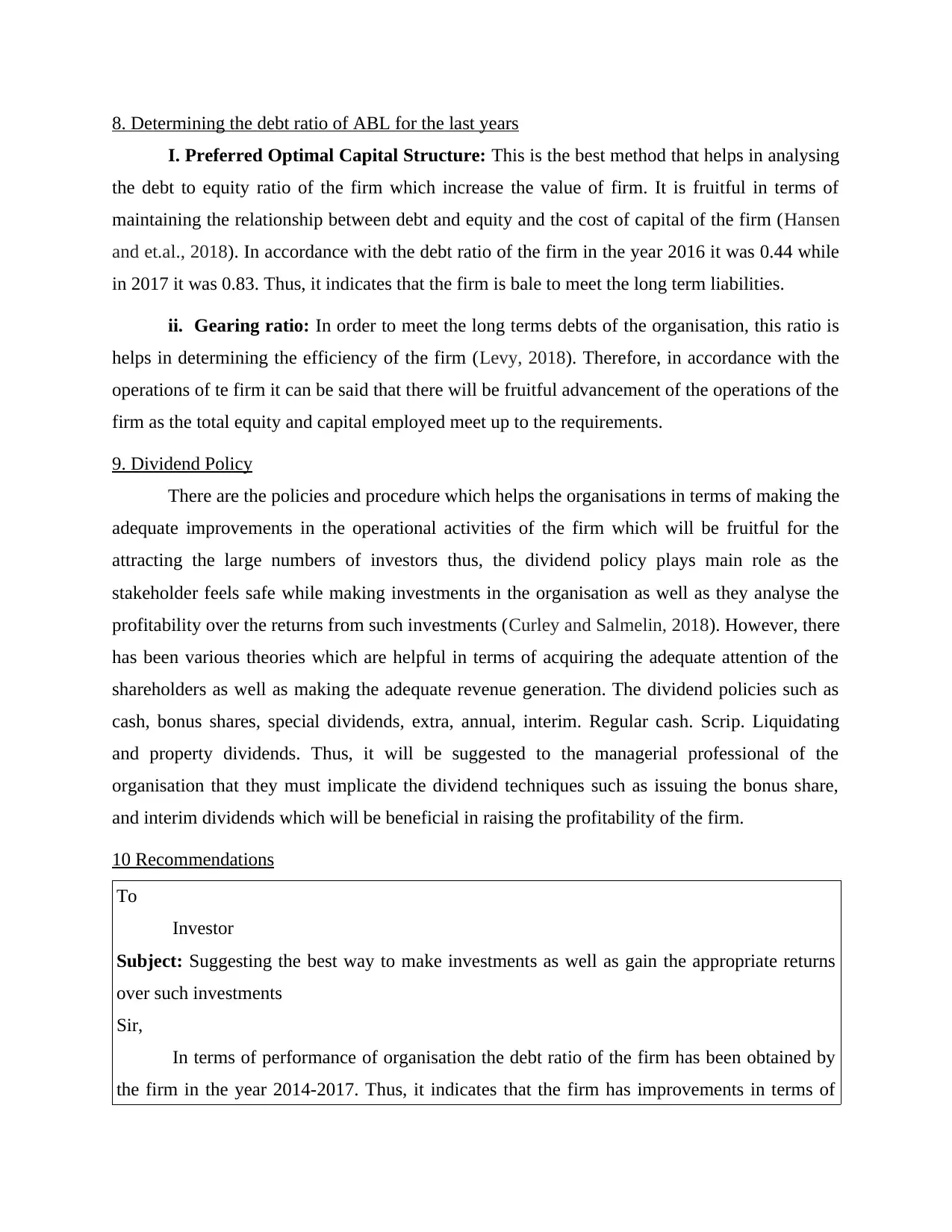
8. Determining the debt ratio of ABL for the last years
I. Preferred Optimal Capital Structure: This is the best method that helps in analysing
the debt to equity ratio of the firm which increase the value of firm. It is fruitful in terms of
maintaining the relationship between debt and equity and the cost of capital of the firm (Hansen
and et.al., 2018). In accordance with the debt ratio of the firm in the year 2016 it was 0.44 while
in 2017 it was 0.83. Thus, it indicates that the firm is bale to meet the long term liabilities.
ii. Gearing ratio: In order to meet the long terms debts of the organisation, this ratio is
helps in determining the efficiency of the firm (Levy, 2018). Therefore, in accordance with the
operations of te firm it can be said that there will be fruitful advancement of the operations of the
firm as the total equity and capital employed meet up to the requirements.
9. Dividend Policy
There are the policies and procedure which helps the organisations in terms of making the
adequate improvements in the operational activities of the firm which will be fruitful for the
attracting the large numbers of investors thus, the dividend policy plays main role as the
stakeholder feels safe while making investments in the organisation as well as they analyse the
profitability over the returns from such investments (Curley and Salmelin, 2018). However, there
has been various theories which are helpful in terms of acquiring the adequate attention of the
shareholders as well as making the adequate revenue generation. The dividend policies such as
cash, bonus shares, special dividends, extra, annual, interim. Regular cash. Scrip. Liquidating
and property dividends. Thus, it will be suggested to the managerial professional of the
organisation that they must implicate the dividend techniques such as issuing the bonus share,
and interim dividends which will be beneficial in raising the profitability of the firm.
10 Recommendations
To
Investor
Subject: Suggesting the best way to make investments as well as gain the appropriate returns
over such investments
Sir,
In terms of performance of organisation the debt ratio of the firm has been obtained by
the firm in the year 2014-2017. Thus, it indicates that the firm has improvements in terms of
I. Preferred Optimal Capital Structure: This is the best method that helps in analysing
the debt to equity ratio of the firm which increase the value of firm. It is fruitful in terms of
maintaining the relationship between debt and equity and the cost of capital of the firm (Hansen
and et.al., 2018). In accordance with the debt ratio of the firm in the year 2016 it was 0.44 while
in 2017 it was 0.83. Thus, it indicates that the firm is bale to meet the long term liabilities.
ii. Gearing ratio: In order to meet the long terms debts of the organisation, this ratio is
helps in determining the efficiency of the firm (Levy, 2018). Therefore, in accordance with the
operations of te firm it can be said that there will be fruitful advancement of the operations of the
firm as the total equity and capital employed meet up to the requirements.
9. Dividend Policy
There are the policies and procedure which helps the organisations in terms of making the
adequate improvements in the operational activities of the firm which will be fruitful for the
attracting the large numbers of investors thus, the dividend policy plays main role as the
stakeholder feels safe while making investments in the organisation as well as they analyse the
profitability over the returns from such investments (Curley and Salmelin, 2018). However, there
has been various theories which are helpful in terms of acquiring the adequate attention of the
shareholders as well as making the adequate revenue generation. The dividend policies such as
cash, bonus shares, special dividends, extra, annual, interim. Regular cash. Scrip. Liquidating
and property dividends. Thus, it will be suggested to the managerial professional of the
organisation that they must implicate the dividend techniques such as issuing the bonus share,
and interim dividends which will be beneficial in raising the profitability of the firm.
10 Recommendations
To
Investor
Subject: Suggesting the best way to make investments as well as gain the appropriate returns
over such investments
Sir,
In terms of performance of organisation the debt ratio of the firm has been obtained by
the firm in the year 2014-2017. Thus, it indicates that the firm has improvements in terms of
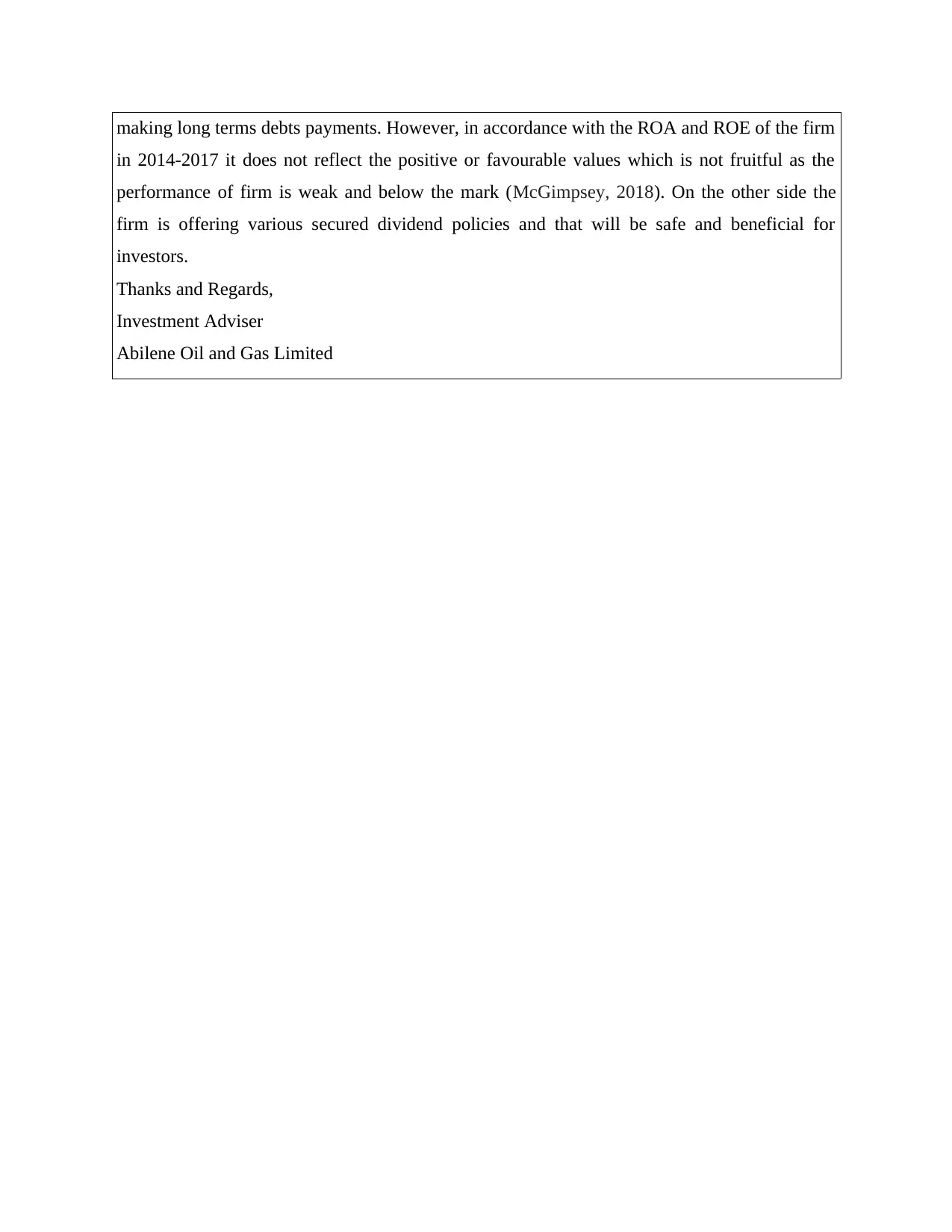
making long terms debts payments. However, in accordance with the ROA and ROE of the firm
in 2014-2017 it does not reflect the positive or favourable values which is not fruitful as the
performance of firm is weak and below the mark (McGimpsey, 2018). On the other side the
firm is offering various secured dividend policies and that will be safe and beneficial for
investors.
Thanks and Regards,
Investment Adviser
Abilene Oil and Gas Limited
in 2014-2017 it does not reflect the positive or favourable values which is not fruitful as the
performance of firm is weak and below the mark (McGimpsey, 2018). On the other side the
firm is offering various secured dividend policies and that will be safe and beneficial for
investors.
Thanks and Regards,
Investment Adviser
Abilene Oil and Gas Limited
⊘ This is a preview!⊘
Do you want full access?
Subscribe today to unlock all pages.

Trusted by 1+ million students worldwide
1 out of 14
Related Documents
Your All-in-One AI-Powered Toolkit for Academic Success.
+13062052269
info@desklib.com
Available 24*7 on WhatsApp / Email
![[object Object]](/_next/static/media/star-bottom.7253800d.svg)
Unlock your academic potential
Copyright © 2020–2025 A2Z Services. All Rights Reserved. Developed and managed by ZUCOL.





